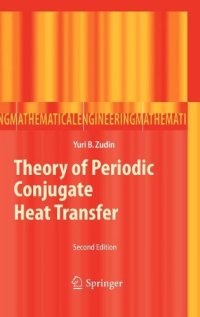
Ebook: Theory of Periodic Conjugate Heat Transfer
Author: Yuri B. Zudin (auth.)
- Tags: Engineering Thermodynamics Heat and Mass Transfer, Appl.Mathematics/Computational Methods of Engineering, Energy Technology, Energy Systems, Applied and Technical Physics, Thermodynamics
- Series: Mathematical Engineering 5
- Year: 2012
- Publisher: Springer-Verlag Berlin Heidelberg
- Edition: 2
- Language: English
- pdf
This book presents the theory of periodic conjugate heat transfer in a detailed way. The effects of thermophysical properties and geometry of a solid body on the commonly used and experimentally determined heat transfer coefficient are analytically presented from a general point of view. The main objective of the book is a simplified description of the interaction between a solid body and a fluid as a boundary value problem of the heat conduction equation for the solid body. At the body surface, the true heat transfer coefficient is composed of two parts: the true mean value resulting from the solution of the steady state heat transfer problem and a periodically variable part, the periodic time and length to describe the oscillatory hydrodynamic effects. The second edition is extended by (i) the analysis of stability boundaries in helium flow at supercritical conditions in a heated channel with respect to the interaction between a solid body and a fluid; (ii) a periodic model and a method of heat transfer simulation in a fluid at supercritical pressure and (iii) a periodic quantum-mechanical model for homogeneous vapor nucleation in a fluid with respect to nanoscale effects.
This book presents the theory of periodic conjugate heat transfer in a detailed way. The effects of thermophysical properties and geometry of a solid body on the commonly used and experimentally determined heat transfer coefficient are analytically presented from a general point of view. The main objective of the book is a simplified description of the interaction between a solid body and a fluid as a boundary value problem of the heat conduction equation for the solid body. At the body surface, the true heat transfer coefficient is composed of two parts: the true mean value resulting from the solution of the steady state heat transfer problem and a periodically variable part, the periodic time and length to describe the oscillatory hydrodynamic effects. The second edition is extended by (i) the analysis of stability boundaries in helium flow at supercritical conditions in a heated channel with respect to the interaction between a solid body and a fluid; (ii) a periodic model and a method of heat transfer simulation in a fluid at supercritical pressure and (iii) a periodic quantum-mechanical model for homogeneous vapor nucleation in a fluid with respect to nanoscale effects.